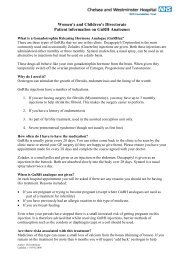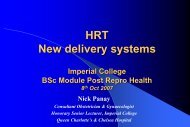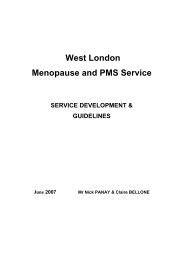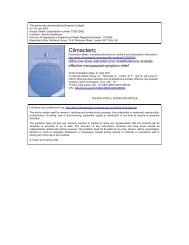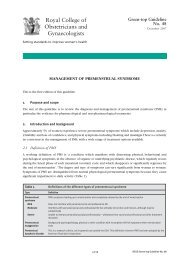Managing menopausal symptoms - Nick Panay
Managing menopausal symptoms - Nick Panay
Managing menopausal symptoms - Nick Panay
Create successful ePaper yourself
Turn your PDF publications into a flip-book with our unique Google optimized e-Paper software.
42<br />
Gynaecology<br />
<strong>Managing</strong> <strong>menopausal</strong><br />
<strong>symptoms</strong><br />
Many women experience devastating <strong>menopausal</strong> <strong>symptoms</strong> to the extent their quality of life<br />
is reduced and daily tasks start to become a burden. Other women suffer only minor, well<br />
manageable <strong>symptoms</strong> that allow them to lead their life as they always have. While the variety<br />
of <strong>symptoms</strong> seems endless, there are few pathways of treatment. Drs Etienne Horner and<br />
Nicholas <strong>Panay</strong> review the management options.<br />
DR ETIENNE HORNER is a consultant obstetrician and gynaecologist,<br />
St Mary’s Hospital, London and DR NICHOLAS PANAY<br />
is a consultant obstetrician and gynaecologist, Queen Charlotte’s<br />
& Chelsea and Chelsea & Westminster Hospital, London<br />
In the light of the controversy since the publication<br />
of the results of the Women’s Health Initiative 1<br />
and the Million Women Study 2 , managing<br />
<strong>menopausal</strong> women has become a very difficult task<br />
for patients, doctors and other healthcare<br />
professionals. The British Menopause Society has<br />
therefore an ‘integrated healthcare pathway for the<br />
<strong>menopausal</strong> woman’ updated and published 3 . The<br />
ovaries are the only endocrine glands (except thymus<br />
and placenta) that cease to function before the end of<br />
life. The median age of the menopause in Western<br />
countries occurs at about 52–54 years. The coming to<br />
an end of ovulation and ovarian endocrine function in<br />
the ageing woman represents a meaningful transition.<br />
Menopause being a normal developmental process,<br />
there is a psychological adjustment as well as physical<br />
and anatomical change. Women in transition to<br />
menopause need to be well informed about all their<br />
current treatment options, and the doctor/healthcare<br />
professional relationship is of utmost importance as<br />
an atmosphere of confidence and trust is mandatory<br />
to achieve satisfying results.<br />
Definitions<br />
The definitions given follow the formulations of the<br />
World Health Organisation (WHO) and the<br />
International Menopause Society (IMS):<br />
> Menopause: a permanent cessation of<br />
menstruation resulting from the loss of ovarian<br />
follicular activity. A natural menopause is<br />
recognised to have occurred after<br />
12 consecutive months of amenorrhea.<br />
There is no adequate marker for this event.<br />
> Pre-menopause: the beginning of the<br />
climacteric transition, which starts a few years<br />
(two to five) before menopause.<br />
REX FEATURES<br />
geriatric medicine / midlife and beyond / january 2007
Gynaecology 43<br />
> Premature menopause: ideally, premature<br />
menopause should be defined as menopause that<br />
occurs at an age more than two standard<br />
deviations below the mean estimate for the<br />
reference population. The age of 40 years is<br />
usually used as an arbitrary cut-off.<br />
> Premature ovarian failure: a condition of<br />
ovarian defect with primary or secondary<br />
amenorrhoea before the age of 40 years.<br />
The Women’s Health Initiative (WHI) 1 and the<br />
Million Women Study 2 have caused considerable<br />
alarm by reporting that venous thromboembolism,<br />
strokes, heart attacks and breast cancer are more<br />
common in women with hormone replacement<br />
therapy (HRT). Unfortunately, both studies were the<br />
focus of press conferences before they were discussed<br />
by the scientific community 4 . The newspaper<br />
headlines are now fixed in the public memory<br />
regardless of any final scientific revision. It will be up<br />
to the doctor to reassure women on HRT about their<br />
treatment with in-depth discussions about risks and<br />
side effects; for those who are about to start with<br />
HRT it should be with the understanding that the<br />
treatment is for specific <strong>symptoms</strong> and low bone<br />
density — and is not a lifestyle drug. Recent smaller<br />
studies, such as the WHISP study of John Stevenson 5 ,<br />
will potentially produce a new message regarding the<br />
risks and benefits of HRT.<br />
The climacteric syndrome<br />
The withdrawal of oestradiol and progesterone<br />
leads to adaptory changes of the hormonal<br />
regulatory system. The autonomous nervous<br />
system is imbalanced and causes typical early<br />
<strong>symptoms</strong> of hormonal deficit. These climacteric<br />
changes are mostly superimposed by <strong>symptoms</strong> of<br />
ageing, which is very distressing for women going<br />
through <strong>menopausal</strong> transition. There are a great<br />
variety of <strong>symptoms</strong> and, together with personal<br />
character and cultural background, this can<br />
complicate the assessment and differential<br />
diagnosis. Vasomotor <strong>symptoms</strong> such as hot<br />
flushes, night sweats and vaginal dryness are the<br />
most current <strong>menopausal</strong> <strong>symptoms</strong>. However, hot<br />
flushes are the earliest and most prominent<br />
<strong>symptoms</strong> of oestrogen deficiency. The prevalence<br />
of hot flushes increases from the premenopause; it<br />
is maximal two to three years after the menopause<br />
and decreases thereafter 6 . In Asian countries, hot<br />
flushes occur less frequently, possibly due to the<br />
higher consumption of soy oestrogens. Vaginal<br />
dryness is seen as a cardinal symptom of<br />
menopause 7,8 and is present in approximately 50<br />
per cent of <strong>menopausal</strong> women. Further<br />
<strong>menopausal</strong> <strong>symptoms</strong> include dysfunctional heart<br />
disorders (palpitations, rapid and irregular heart<br />
beats), sleep disorders, mood changes, irritability,<br />
anxiety, tiredness, lack of energy, memory loss,<br />
urogynaecological <strong>symptoms</strong> (dysuria,<br />
pollakisuria, stress/urge incontinence, recurrent<br />
cystitis), bone loss and lack of libido. This is not a<br />
complete list of <strong>symptoms</strong> but the above<br />
mentioned seem to be the most frequent.<br />
The Melbourne Women’s Midlife Project 9 — at a<br />
duration of nine years — is the longest study of<br />
women through the <strong>menopausal</strong> transition and<br />
examined 33 <strong>symptoms</strong>. Vasomotor <strong>symptoms</strong>,<br />
insomnia, vaginal dryness and breast tenderness<br />
changed significantly during early and late<br />
<strong>menopausal</strong> transition.<br />
Lack of libido<br />
The female androgen deficiency syndrome (FADS)<br />
is characterised by loss of energy, loss of libido,<br />
depression, loss of self confidence and headaches.<br />
These are also frequent complaints in women who<br />
have had a hysterectomy and oophorectomy.<br />
Twenty to 40 per cent of women suffer from female<br />
sexual dysfunction (FSD) 10 . For many women it is<br />
physically disconcerting, emotionally distressing<br />
and socially disruptive 11 . FSD is classified in four<br />
different disorders: sexual desire, sexual arousal,<br />
orgasmic and sexual pain disorders. This definition<br />
of different FSD may be helpful for the clinician<br />
in correctly approaching the complaints and<br />
therapy possibilities.<br />
Bone loss<br />
Osteoporosis is a metabolic bone disease<br />
characterised by a low bone mass and<br />
microarchitectural deterioration of bone tissue<br />
followed by enhanced bone tissue 12 . In <strong>menopausal</strong><br />
women, bone loss occurs as a result of the increase in<br />
the level of bone resorption as compared to the level<br />
of bone formation. This is induced by oestrogen<br />
deficiency together with age. In the first five years<br />
after the menopause bone loss is accelerated to about<br />
one to five per cent per year. Afterwards, the bone<br />
loss stabilises at about 0.5 per cent per year 13 . With<br />
declining levels of bone mass the fracture risk<br />
becomes gradiently higher.<br />
Cardiovascular disease<br />
Cardiovascular disease is one of the main causes of<br />
january 2007 / midlife and beyond / geriatric medicine
44<br />
Gynaecology<br />
death in women in the twenty-first century.<br />
Menopause is associated with an increased risk of<br />
cardiovascular disease and outnumbers other classical<br />
causes of death in women, such as breast, cervical and<br />
ovarian cancer. Pre<strong>menopausal</strong> women seem to be<br />
protected from cardiovascular disease compared with<br />
men in the same age range. The increased risk after<br />
menopause may be explained by oestrogen deficiency,<br />
responsible for the rapid acceleration of the<br />
cardiovascular risk, and by changes in abdominal fat<br />
content and worsening of blood lipid content 14 .<br />
Depression<br />
Depression is more common in women than in men 15 .<br />
The challenge is to determine whether the increase in<br />
depression is environmental or due to hormonal<br />
changes. The peaks of depression occur at times of<br />
hormonal fluctuation such as in the premenstrual, the<br />
postpartum and the peri<strong>menopausal</strong> phases. Women<br />
around the time of their menopause can suffer from<br />
increased depression two to three years before their<br />
periods stop. One of the first placebo-controlled<br />
studies against hot flushes, night sweats and vaginal<br />
dryness also had a mood elevating effect 16 . This study<br />
defined the <strong>menopausal</strong> syndrome and confirmed that<br />
oestrogens improved not only vasomotor <strong>symptoms</strong>,<br />
but also alleviated mood.<br />
Urogenital atrophy<br />
Oestrogen deficiency in menopause causes atrophic<br />
changes within the urogenital tract and therefore is<br />
associated with <strong>symptoms</strong> of frequency, urgency,<br />
nocturia, incontinence and finally recurrent<br />
infections 17 . To these <strong>symptoms</strong> more <strong>symptoms</strong> of<br />
vaginal atrophy can be added such as dyspareunia,<br />
burning, itching and dryness. It has been estimated<br />
that 10–40 per cent of all <strong>menopausal</strong> women are<br />
symptomatic 18 .<br />
Treatment options<br />
Treatment options fall under three headings: lifestyle<br />
changes; alternative and complementary therapies;<br />
and HRT.<br />
Lifestyle changes: Before commencing any<br />
medical treatment it is very important to ensure that<br />
lifestyle has been optimised. There is some evidence<br />
that women who are more active tend to suffer less<br />
from <strong>menopausal</strong> <strong>symptoms</strong> 19 . Unfortunately, not all<br />
types of activity improve <strong>menopausal</strong> <strong>symptoms</strong>. The<br />
best activities are regular exercises, such as running<br />
and swimming. Menopausal <strong>symptoms</strong> can also be<br />
geriatric medicine / midlife and beyond / january 2007
46 Gynaecology<br />
aggravated by social and environmental factors and<br />
therefore reduction of stress can be helpful in<br />
ameliorating these <strong>symptoms</strong>. Limiting the intake of<br />
caffeine and alcohol can also reduce the severity and<br />
frequency of vasomotor <strong>symptoms</strong> 20 .<br />
Alternative and complementary therapies: There<br />
is poor evidence from randomised trials that<br />
alternative and complementary therapies improve<br />
<strong>menopausal</strong> <strong>symptoms</strong>, or even have the same benefits<br />
as non-oestrogen based treatments or HRT. Women<br />
often perceive complementary therapies to be a safe<br />
alternative to traditional hormone therapies. But<br />
there is concern these therapies may interact with<br />
other treatments with potentially fatal consequences.<br />
Some preparations may contain oestrogenic<br />
compounds and this could be a problem for women<br />
with oestrogen positive breast cancer. Phytooestrogens<br />
(soy, red clover, chick peas) are plant<br />
substances with similar effects to those of oestrogens.<br />
Japanese women appear to have lower rates of<br />
<strong>menopausal</strong> vasomotor <strong>symptoms</strong>, cardiovascular<br />
disease and osteoporosis as well as breast, colon,<br />
endometrial and ovarian cancers 21 . Herbal remedies<br />
— including black cohosh, evening primrose oil, dong<br />
quai, ginseng and wild yam cream — are widely used<br />
by <strong>menopausal</strong> women. With all alternative<br />
preparations the efficacy is maximally 50–60 per cent.<br />
We also should not forget some alternatives have their<br />
own adverse effects and risks — warnings have<br />
already been issued by regulatory bodies for<br />
some products.<br />
HRT: Even though menopause is not lifethreatening,<br />
for most women it interferes with quality<br />
of life. It seems the dilemma of balancing the benefits<br />
and risks of available therapies is probably greater for<br />
doctors than for patients 22 . Oestrogen-based<br />
treatments still play a major role in the treatment of<br />
<strong>menopausal</strong> <strong>symptoms</strong>. Treatment choice should be<br />
based on up-to-date information and targeted to an<br />
individual woman’s need. HRT still offers the<br />
potential for the benefit to outweigh the harm,<br />
providing the appropriate regimen has been instigated<br />
in terms of dose, route and combination 23 .<br />
The success of HRT depends primarily on a good<br />
patient/doctor relationship and on compliance from<br />
both sides. The fears, doubts, expectations and wishes<br />
of the patient should be thoroughly discussed prior to<br />
start in order to create an atmosphere of trust<br />
between patient and doctor. HRT consists of an<br />
oestrogen combined with a progestogen in nonhysterectomised<br />
women. Different routes of systemic<br />
administration — such as oral, transdermal,<br />
References<br />
1. Rossouw JE, Anderson GL,<br />
Prentice RL et al; Writing Group<br />
for the Women’s Health Initiative<br />
Investigators. Risks and benefits<br />
of estrogen plus progestin in<br />
healthy post<strong>menopausal</strong> women:<br />
principal results From the<br />
Women’s Health Initiative<br />
randomized controlled trial. JAMA<br />
2002 Jul 17; 288(3): 321-33<br />
2. Beral V. Million Women Study<br />
Collaborators. Breast cancer and<br />
hormone-replacement therapy in<br />
the Million Women Study. Lancet<br />
2003 Aug 9;362(9382):419-27<br />
3. Rees M, Purdie DW.<br />
Management of the menopause.<br />
The British Menopause Society,<br />
September 2006<br />
4. Studd JWW. ‘Up to general<br />
practice to pick up the pieces’<br />
what pieces A response to WHI<br />
and MWS. Maturitas 2003; 46:<br />
95-7<br />
5. Collins P, Flather M, Lees B et al;<br />
WHISP (Women’s Hormone<br />
Intervention Secondary<br />
Prevention Study) Pilot Study<br />
Investigators. Randomized trial of<br />
effects of continuous combined<br />
HRT on markers of lipids and<br />
coagulation in women with acute<br />
coronary syndromes: WHISP<br />
Pilot Study. Eur Heart J 2006<br />
Sep;27(17):2046-53<br />
6. Guthrie JR, Dennerstein L, Taffe<br />
JR, et al. Hot flushes during the<br />
menopause transition: a<br />
longitudinal study in Australianborn<br />
women. Menopause 2005<br />
Jul-Aug;12(4):460-7<br />
7. Van Keep PA, Kellerhals J. The<br />
impact of socio-cultural factors<br />
on symptom formation. Psycho<br />
Ter Psychosomat 1974;23:251<br />
8. Utian WH. Definitive <strong>symptoms</strong> of<br />
postmenopause-incorporating<br />
use of vaginal parabasal cell<br />
index. In: Oestrogen in the<br />
Postmenopause, Vol 3. Front<br />
Hormone Res 1975; 74-89<br />
9. Burger H, Dudley E, Hopper J et<br />
al. Prospectively measured levels<br />
of serum FSH, oestradiol and the<br />
dimeric inhibins during the<br />
<strong>menopausal</strong> transition in a<br />
population-based cohort of<br />
women. J Clin Endocrinol Metab<br />
1999; 84: 4025-30<br />
10.Avis NE, Stellato R, Crawford S,<br />
et al. Is there an association<br />
between menopause status and<br />
sexual functioning Menopause<br />
2000 Sep;5:297-309<br />
11.Basson R, Berman J, Burnett A et<br />
al. Report of the international<br />
consensus development<br />
conference on female sexual<br />
dysfunction: Definitions and<br />
classifications. J Urol 2000; 163:<br />
888-93<br />
12.Consensus Development<br />
Statement. Who are candidates<br />
for prevention and treatment for<br />
osteoporosis Osteoporosis Int<br />
1997;7: 1-6<br />
13.Bjarnason NH, Alexanderson P,<br />
Christiansen C. Number of years<br />
since menopause: spontaneous<br />
bone loss is dependent, but<br />
response to HRT is independent.<br />
Bone 2002;30: 637-42<br />
14.Poehlmann ET, Toth MJ, Gardner<br />
AW. Changes in energy balance<br />
and body composition at<br />
menopause: a controlled<br />
longitudinal study. Ann Intern<br />
Med 1995; 123: 673-75<br />
15.Studd JWW, <strong>Panay</strong> N. Hormones<br />
and depression in women.<br />
Climacteric 2004; 7: 338-46<br />
16.Utian WH. The mental tonic effect<br />
of oestrogens administered to<br />
oophorectomized females. S Afr<br />
Med J 1972;46(3):1079-82<br />
17.Iosif C, Bekassy Z. Prevalence of<br />
genitourinary <strong>symptoms</strong> in the<br />
late menopause. Acta Obstet<br />
Gynecol Scand 1984;63: 257-60<br />
18.Greendale DA, Judd JL. The<br />
menopause: health implications<br />
and clinical management. J Am<br />
Geriatr Soc 1993;41: 426-36<br />
19.Lindh-Astrand L, Nestrand E,<br />
Wyon Y, Hammar M. Vasomotor<br />
<strong>symptoms</strong> and quality of life in<br />
previously sedentary<br />
post<strong>menopausal</strong> women<br />
randomised to physical activity or<br />
estrogen therapy.Maturitas<br />
2004;48(2):97-105<br />
20.Greendale GA, Gold EB. Lifestyle<br />
factors: are they related to<br />
vasomotor <strong>symptoms</strong> and do<br />
they modify the effectiveness or<br />
side effects of hormone therapy<br />
Am J Med. 2005;118(12 Suppl<br />
2):148-54<br />
21.Balk E, Chung M, Chew P, et al.<br />
Effects of soy on health<br />
outcomes. Evid Rep Technol<br />
Assess (Summ) 2005;(126):1-8<br />
22.Davis SR. Menopause: New<br />
therapies. Med J Aust 2003;<br />
178:634-37<br />
23.BMS Council Consensus<br />
Statement on HRT. <strong>Managing</strong> the<br />
Menopause, J BMS 2004; 33-36<br />
24.MacLennan A, Lester S. Moore V.<br />
Oral estrogen replacement<br />
therapy versus placebo for hot<br />
flushes: a systematic review.<br />
Climacteric 2001;4(1):58-74<br />
25.Cardozo L, Bachmann G, McClish<br />
D, et al. Meta-analysis of<br />
estrogen therapy in the<br />
management of urogenital<br />
atrophy in post<strong>menopausal</strong><br />
women: second report of the<br />
Hormones and Urogenital<br />
Therapy Committee. Obstet<br />
Gynecol 1998;92(4 Pt 2):722-7<br />
26.Lees B, Stevenson JC. The<br />
prevention of osteoporosis using<br />
sequential low-dose hormone<br />
replacement therapy with<br />
oestradiol-17 beta and<br />
dydrogesterone. Osteoporos Int<br />
2001;12: 251-58<br />
27.Shifren JL, Davis SR, Moreau M,<br />
et al. Testosterone patch for the<br />
treatment of hypoactive sexual<br />
desire disorder in naturally<br />
<strong>menopausal</strong> women: results from<br />
the INTIMATE NM1 Study.<br />
Menopause 2006;13(5): 770-<br />
779<br />
28.RCPE (2003) Consensus<br />
conference on hormone<br />
replacement therapy, October<br />
2003. Final consensus statement.<br />
Royal College of Physicians of<br />
Edinburgh. J rcp Edin2<br />
29.Fournier A, Berrino F, Riboli E, et<br />
al. Breast cancer risk in relation to<br />
different types of hormone<br />
replacement therapy in the E3N-<br />
EPIC cohort. Int J Cancer 2004;<br />
114(3): 448-454<br />
31.Sands R, Studd JWW. Exogenous<br />
androgens in post<strong>menopausal</strong><br />
women. Am J Med 1995 Jan<br />
16;98(1A):76S-79S<br />
32.North American Menopause<br />
Society. The role of testosterone<br />
therapy in post<strong>menopausal</strong><br />
women: position statement of<br />
The North American Menopause<br />
Society. Menopause, 2005 Sep-<br />
Oct; 12(5):496-511<br />
geriatric medicine / midlife and beyond / january 2007
Gynaecology<br />
47<br />
Key points<br />
• Hot flushes can have detrimental effect on work<br />
life and also a damaging effect on the sex life.<br />
• HRT can help prevent osteopenia and<br />
osteoporosis.<br />
• The choice of taking HRT or not will depend on<br />
the extent of <strong>symptoms</strong> together with health and<br />
personal wishes.<br />
• Treatment will always be a personal, very individual<br />
decision by every woman going through the<br />
menopause and no one treatment is mandatory.<br />
• Women benefit greatly from an integrated<br />
approach involving a continuing relationship with<br />
sensitive and well-informed clinicians.<br />
subcutaneous and intranasal — are employed.<br />
Essentially oestrogen is given for the treatment of<br />
climacteric <strong>symptoms</strong> and for the improvement of low<br />
bone density.<br />
There is good evidence from randomised<br />
controlled trials that oestrogen is effective to treat<br />
vasomotor <strong>symptoms</strong> and improvement is usually<br />
noted within four weeks 24 . This is also the most<br />
common indication for HRT. Urogenital <strong>symptoms</strong><br />
respond very well to oestrogens too, but improvement<br />
may take several months and long-term treatment is<br />
often required 25 . Oestrogens also reduce the risk of<br />
spine and hip as well as other osteoporotic fractures.<br />
There used to be a dose of 2mg oestradiol daily as a<br />
bone conserving dose, but it is now evident that half of<br />
the dose conserves bones similarly 26 .<br />
Low libido may be improved with oestrogen<br />
therapy, but often adding testosterone leads to better<br />
results. Testosterone is indicated for women who<br />
present with the classical clinical <strong>symptoms</strong> of sexual<br />
dysfunction and/or lack of energy. Currently in the<br />
UK, testosterone for women is only licensed as an<br />
implant. Testosterone as a patch has been investigated<br />
over the last few years; the results are very promising<br />
in terms of efficacy and safety as well as increased<br />
frequency of satisfying sexual activity, and it is well<br />
tolerated in <strong>menopausal</strong> women 27 .<br />
Conclusion<br />
HRT during menopause is an attempt to prolong a<br />
euhormonal state and to maintain an endocrine<br />
autonomous balance. The treatment is very effective,<br />
well tolerated and, if properly indicated and<br />
administered, it is a low-risk procedure. Advice from<br />
most regulatory authorities following the Women’s<br />
Health Initiative Study and Million Women Study<br />
have recommended that HRT should be continued for<br />
the shortest possible time in the lowest dose 28 . It has<br />
been suggested five years should be the time for<br />
cessation of therapy, as an apparent increase of breast<br />
cancer occurs after this time 29 . In the long term,<br />
substantive bone loss and cardiovascular disease<br />
can be prevented if they are due to oestrogen<br />
deficiency and have started with menopause.<br />
Androgen supplementation is likely to become<br />
standard practice in <strong>menopausal</strong> women<br />
as large randomised controlled trials have<br />
shown a psychological and physical benefit<br />
of adding testosterone to oestrogen/progestogen<br />
therapies 30,31 .<br />
Conflict of interest: Drs Horner and <strong>Panay</strong> have<br />
both acted in an advisory capacity and lectured for<br />
a number of pharmaceutical companies that<br />
manufacture HRT-related products.<br />
REX FEATURES<br />
january 2007 / midlife and beyond / geriatric medicine



